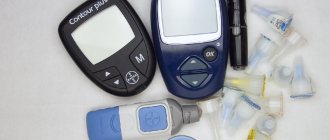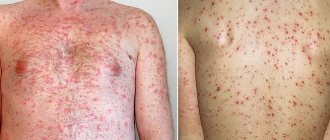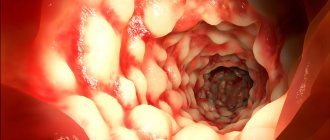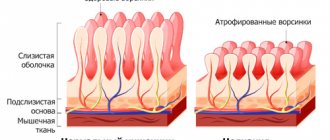It is necessary to take care of your health from a young age.
This axiom, unfortunately, is not taken into account by many. People hope that bad habits, an unbalanced diet and a disorganized lifestyle will not cause irreparable harm to their body. This rhythm of life becomes habitual, and as a result a person has to make every effort to change it and make it more beneficial for his body. The most important thing in maintaining human health at the level necessary for normal life is the nutritional factor. As the ancients said, “I am what I eat.” This expression lays the foundations for a healthy, balanced diet.
With an organized and nutritious diet, a certain amount of proteins, fats, carbohydrates, as well as vitamins and microelements must enter the human body.
Signs of Vitamin E Deficiency
A lack of vitamin E can be caused by congenital disorders that prevent the body from properly absorbing fats, which contain vitamin E.
In infants, vitamin deficiency can occur during artificial feeding, especially when there is an excess of polyunsaturated fatty acids in the diet. In older children, vitamin deficiency in the body can be caused by a lack of protein in the diet.
In adults, nutritional disorders are less likely to lead to vitamin deficiency, and vitamin E deficiency most often occurs against the background of some disease or hormonal disorder.
General symptoms of vitamin E deficiency in the body:
- Impaired coordination of movements.
Vitamin deficiency causes oxidative stress in the body and, as a result, leads to tissue and cell damage. This affects the functioning of the central nervous system: a person has weak reflexes, disturbances of the vestibular apparatus, and poor coordination of movements. - Anemia
. A decrease in red blood cells in the blood prevents cells from developing normally, which leads to deterioration in vital functions: weakness, apathy, fatigue, frequent depression and chronic fatigue. - Muscle disorders
. Vitamin deficiency leads to the development of myopathy - a disorder in which the fibers of muscle tissue are weakened and the muscles can no longer function normally. - Deterioration of vision
. Various vision problems can occur, but the most common cases are thinning of the retina: blurred vision and impaired night vision.
External symptoms
lack of vitamin E:
- Hair begins to break, lose shine and become dull;
- The skin loses its elasticity (this causes fine wrinkles to appear), the skin becomes prone to increased pigmentation;
- Pallor appears (due to anemia), the person looks sick and lethargic.
Symptoms of vitamin deficiency also appear in the functioning of internal organs:
- Signs of muscular dystrophy appear;
- Metabolism is disrupted;
- The reproductive system is disrupted;
- Anemia develops;
- There are disorders and inflammations in the digestive tract.
A constant lack of vitamin E in the body can lead to chronic diseases, and in some cases to disability.
Consequences of vitamin E deficiency
Symptoms of incipient vitamin E deficiency may manifest differently depending on age, the severity of the disease and the causes of its occurrence.
Consequences of vitamin E deficiency in infants
Vitamin deficiency is often observed in newborns with low birth weight, as well as in infants who are bottle-fed. This can lead to:
- To problems in mental and physical development:
- To weight loss and growth retardation:
- Impaired appetite;
- To retrolental fibroplasia (serious eye disease).
Consequences of vitamin E deficiency in children
Vitamin deficiency can occur in children with poor diet and digestive disorders. A chronic lack of vitamin E can lead to:
- To muscle weakness;
- To slow growth and mental development;
- Loss of orientation in space;
- To disturbances of muscle reactions in the trunk and limbs;
- To vision problems: drooping of the upper eyelid and paralysis of the eye muscles;
- To chronic diseases of the gastrointestinal tract and liver.
Consequences of vitamin E deficiency in adults
Vitamin E in insufficient quantities can lead to various disorders in the body and the development of some chronic diseases. With its deficiency in adults, the following occurs:
- Neurological damage of various types;
- Skin pigmentation and sagging skin;
- Sexual disorders (infertility);
- Deviations in the functions of the bone marrow, brain, muscles, liver;
- Hemolytic anemia of moderate severity.
A lack of vitamin E, especially in old age, can lead to frequent cramps in the calves and pain when walking. These symptoms (pain and cramps) begin to intensify over time, and the person begins to stumble and limp while walking. This condition can cause intermittent claudication and, over time, disability.
Why does vitamin deficiency occur?
Several external and internal environmental factors are considered predisposing to the development of vitamin deficiency. E-vitaminosis occurs most often due to the following reasons:
- Poor nutrition. An insufficient amount of the substance enters the human body with food, which leads to the appearance. Poor nutrition is a key cause of many ailments, including hypovitaminosis or vitamin deficiency.
- Metabolic disorder. Tocopherol is fat soluble and is absorbed from the gastrointestinal tract. In the presence of inflammatory processes or other pathologies of the digestive system, the absorption of substances significantly worsens, which leads to a lack of nutrients and other valuable compounds in the body.
- Exposure to toxins. Many toxic substances interfere with the normal metabolism of beneficial substances and often lead to polyvitaminosis of several vitamins.
If a symptom of vitamin E deficiency appears in a newborn child, this can be explained by the fact that this substance does not penetrate the placental barrier well and with adequate nutrition with mother's milk or an adapted formula, the deficiency will quickly be replenished. Accurate knowledge of the cause of the pathology is necessary to choose the correct treatment tactics and prevention of this condition.
Treatment of vitamin E deficiency
To eliminate the lack of vitamin E in the body, a special diet is prescribed, including the following products:
- Unrefined vegetable oils (linseed, olive);
- Nuts;
- Bran;
- Milk and dairy products;
- Sprouted wheat varieties;
- Salad leaves and parsley;
- Spinach;
- Legumes;
- Tomatoes;
- Rose hip;
- White cabbage.
If a lack of vitamin E has already led to serious disorders in the body, a nutritionist or therapist may prescribe an additional dose of vitamin E (up to 100 g per day, at the doctor’s discretion).
Vitamins A and E in cosmetology
There are many similarities between the vitamins discussed above.
First of all, they both affect the condition of the skin in one way or another and are included in creams, lipsticks, shampoos and other caring cosmetics. For example, topical application of oil containing vitamin E speeds up the healing process of acne and prevents the formation of pores. Plus, by lubricating your belly and chest daily, you will avoid the appearance of stretch marks, scars, rashes and age spots. It also reduces transepidermal water loss from the skin surface. Thanks to these properties, even in old age you will look young. True, such products are unlikely to fully compensate for the lack of fat-soluble vitamins a and e in the body of the fair sex. By the way, it should be noted that some scientists argue that the local use of such funds is useless. But still, some recipes are worth trying.
Nourishing skin masks made from flakes
Ingredients:
- Oatmeal – 2 tablespoons;
- Lemon juice – 10-15 drops;
- Vitamin E (sold in the pharmacy in the form of oils) – 5 drops.
Method of preparation:
Mix all ingredients and immediately apply a small amount of the resulting product to your face (pre-cleaned). After 10 minutes, rinse your skin with cold water (or then wipe with an ice cube) and apply a nourishing cream. It is recommended to make such masks once a week.
Nourishing skin masks made from cottage cheese
Ingredients:
- Vegetable oil – 2 teaspoons;
- Fatty (household) vorog - 2 tablespoons;
- Vitamin E – 3-4 drops.
Mix the above ingredients thoroughly, then apply the resulting mixture to problem areas. Exposure time – 15 minutes. Then rinse off the mask with plenty of water and wipe with a dry towel. Repeat the procedure after 4 days. Do not forget to first test such products on the bend of your elbow to avoid an allergic reaction. By the way, experts recommend consuming vitamins a and e comprehensively, that is, together.
Preventing vitamin E deficiency
The recommended prophylactic dose of vitamin E varies in each case and depending on age and gender. The optimal daily dose of vitamin E should not be 400-600 IU for an adult in normal health. In other cases, the dosage is prescribed by the doctor.
Experts say that a lack of vitamin E is now not felt in any family, because almost everywhere dishes are prepared daily using vegetable oils. But nevertheless, to prevent vitamin E deficiency, it is necessary to constantly include foods containing it in the diet. This is especially true during the period of spring vitamin deficiency, when there is an acute shortage of greens on the table.
If a lack of vitamin E is still noticeably felt despite a review of the diet, you need to purchase vitamin E capsules at the pharmacy and drink them according to the instructions or in doses prescribed by your doctor.
Stimulation of cellular respiration
Vitamin E reliably protects red blood cells, or red blood cells, from damage, which carry oxygen from the lungs to all organs and tissues of the body, and thereby helps stimulate the respiration of all cells of our body. However, at the same time, he also makes sure that the body’s tissues get by with as little oxygen as possible, and therefore their endurance and strength increases. In athletes and other people leading an active lifestyle, more air passes through the lungs, and, accordingly, more oxygen is “pumped” into the blood and tissues. And it can pose a danger by stimulating oxidative processes and breaking down into free radicals, or so-called peroxides. That is why people who lead an active lifestyle
, it is very
important to monitor
the timely replenishment of
vitamin E
in the body.
Vitamin E
can prevent or eliminate various circulatory disorders, in particular, it reduces blood clotting and
prevents the formation of blood clots in blood vessels.
Also, it protects the most important endocrine glands - the hypothalamus, thymus and adrenal cortex. Vitamin E deficiency entails a decrease in sperm production in men and various dysfunctions of the reproductive system in women. In addition, vitamin E protects the molecules of another vitamin, vitamin A, from the harmful effects of free radicals. Both of these vitamins are among the most important protective factors of the eyes, primarily the retina and lens.
Anti-inflammatory effect of vitamin E
Vitamin E has one more quality that scientists have discovered only in recent years. It prevents the development of inflammatory processes in the body,
which recently often arise due to poor nutrition. Vitamin E inhibits the production of substances that stimulate the inflammatory response, in particular leukotrienes and prostaglandins, which accumulate in the body when eating excess meat. Meat contains arachidonic acid, which becomes the material for the subsequent production of leukotrienes and prostaglandins in body tissues. In people who consume large amounts of meat and at the same time insufficient intake of vitamin E, an excess amount of arachidonic acid is concentrated in the body, resulting in the active production of substances that stimulate inflammatory processes.
What are the first signs of vitamin E deficiency?
- Decreased visual acuity
- Skin laxity
- Increased fatigue
- Inflammatory diseases of the gastrointestinal tract
- Infertility
- Cardiovascular diseases
- Nervousness, increased irritability
- Absent-mindedness
- The appearance of age spots on the skin
How does vitamin E enter the body?
First of all, vitamin E is found in vegetable fats,
which are extracted from various seeds (in particular, sunflower, olive, soybean, rapeseed oils, etc.). Being in plant seeds, this vitamin already performs its function of protecting unsaturated fatty acids, which are very unstable to irradiation by sunlight, from the oxidation process caused by free radicals.
In the intestinal lumen, vitamin E is absorbed “in conjunction” with fat molecules. And therefore, just like other fat-soluble vitamins (these include vitamins A, D and K), vitamin E requires
constant
presence of fats in food
, because even completely normal digestive processes allow us to absorb only 20 to 40% of the vitamin E entering the body with food.
First, vitamin E is “packed” into a protein shell, forming a so-called chylomicron, and in this form it is sent directly to the liver through the lymphatic system. From there, vitamin E travels through the bloodstream in the same way to cell membranes or fatty tissues as triglycerides and other fat-like substances. Thanks to this long path, the distribution of vitamin E in the body occurs more evenly than the distribution of similar fat-soluble vitamins A and D. And thanks to the fact that nature ordered it this way, excessive consumption of vitamin E is not nearly as dangerous and toxic
, like an overdose of vitamins A and D. Up to 99% of all vitamin E in the body sleeps peacefully in fat cells along with triglycerides - the “culprits” for the appearance of fat deposits on our stomachs, buttocks and thighs.
Prevention of atherosclerosis
Alpha-tocopherol, the most “effective” form of vitamin E, circulates in the blood in conjunction with the so-called low-density cholesterol, which is mistakenly considered to be the culprit in the development of atherosclerosis. Yes, this molecule contains a large amount of fat, but with proper nutrition (in particular, when eating large quantities of vegetable fats), this fat is perfectly absorbed and does not cause any harm to the body. Moreover, it is low-density cholesterol that ensures the delivery of vitamin E
to the most remote corners of our body.
If you eat
large quantities of white bread, fatty sausage, pasta and confectionery, sugar and all sorts of other
“empty” foods
, then the liver will have nothing left but to process them into additional fat and then send them into the blood. Without outside help, these lipid substances only accumulate in the blood because the body's cells do not accept them. Finally, they begin to “gather” in the walls of the arteries, gradually narrowing the lumen of the vessels more and more and thus causing atherosclerosis. And large reserves of the most useful vitamin E remain unused.
How does Vitamin E work?
How to help damaged cells and what foods contain Vitamin E... you will learn from the third part of the article.
What do women most often dream about: beauty, youth and the opportunity to give birth to a healthy child? But in order to bring all this to life, you need not only to lead a healthy lifestyle, but also not to forget about vitamins and minerals. A lack of vitamin E not only slows down or disrupts the natural renewal of body cells, but can also cause problems with conception or even provoke secondary infertility, both in women and men.
Vitamin E: with or without it
Vitamin E, which is popularly considered “feminine”, is no less important for the human body. It has characteristic antioxidant properties and helps fight free radicals. Plus, without it, pregnant women will not be able to bear a child normally. There are eight different forms in which vitamin E is present, including 4 tocopherols and 4 tocotrienols.
Vitamin E deficiency
Lack of vitamins (E, A, etc.) is a serious cause for concern.
So, for example, with vitamin deficiency, a woman simply will not be able to conceive, and a man will simply not be able to fertilize. If you still manage to get pregnant, the expectant mother will be exposed to serious risks. There are frequent cases of spontaneous abortions. Deficiency also negatively affects the central nervous system and the functioning of the thyroid gland and pituitary gland. The first signs: fatigue, apathy, emotional instability, general weakness, poor health. You should contact a specialist with complaints if you are constantly sick for a long time. By the way, in this case you should also check the liver, pancreas and gall bladder.
With vitamin deficiency, people become more irritable. They may develop severe anemia, both in adults and children. Free radicals damage cells and cause diseases such as cancer, thromboembolism, etc. The main task of vitamin E is to protect the body from harmful substances.
By the way, sometimes a course of treatment is prescribed if a representative of the fair sex has the following diseases: mastopathy, retrolental fibroplasia, intraventricular bleeding. And these are not only drugs, but also a special diet. The fact is that many medical disorders and diseases can be prevented if you start eating right.
In fact, vitamin E deficiency is rare. However, it can occur in women whose bodies cannot absorb fats normally. This usually happens to representatives of the fair sex, who are well over 50, with small children. People who take drugs and alcohol are also susceptible to this disease. Pay special attention to the fact that vitamin E deficiency is also a common problem in people who are on frequent diets.
Girls who have suffered burns or injuries or have undergone surgery must include foods rich in vitamin E in their diet to compensate for its deficiency. Those who often suffer from stress for a long time or have cystic fibrosis and celiac disease should also increase their intake of such foods. But this must be done only under the strict supervision of a doctor so that existing diseases do not progress.
Excess vitamin E: is it harmful to our health?
Our daily norm is 13-14 g. In case of exacerbation of certain diseases, severe physical exertion, during pregnancy, breastfeeding, as well as for older people, the dose is increased. Usually, excess vitamin E does not affect our body in any way, but you should still not abuse certain medications.
What does vitamin E contain?
If a person eats normally, he is unlikely to encounter the problem of vitamin deficiency. This vitamin occurs naturally in a variety of foods, including milk, eggs, herbs, vegetables, nuts, seeds, and grains. The body's daily need for vitamin E can be compensated by medications that are sold in pharmacies in the form of tablets and capsules. A lot of it is also found in oil (sesame, sunflower, hemp). Please note that in order for tocopherols to be absorbed normally, you must eat fatty foods.
Vitamin E and its importance for the body
Vitamin E or tocopherol is one of the most mysterious natural compounds. Each molecule of a substance is unique in its composition, although it consists of only 3 elements: hydrogen, oxygen and carbon, but their combination is always different. The importance of vitamin E was known to the ancient Greeks - “tocopherol” translated from Greek means “bringing offspring”, because without it, as has been proven, the existence and reproduction of mammals is almost impossible.
The main function of vitamin E in the body
– protects cell membranes from free radicals. Today, antioxidant substances are at the peak of popularity, but nothing more useful than vitamin E has yet been invented. This substance stabilizes the cell membrane, preventing its destruction; a sufficient amount of vitamin E can improve metabolism between cells, protect them from premature destruction and activate functions. For example, tocopherols tightly surround erythrocytes - red blood cells that carry oxygen from the lungs to the tissues. If there is not enough vitamin E in the body, free radicals destroy the membranes of red blood cells and oxygen starvation develops in the body.
Vitamin E is necessary for the synthesis of hormones, including sex hormones, maintaining vascular tone and regeneration of cells and tissues. Lack of vitamin E causes premature aging of the skin epithelium, metabolic disorders, decreased secretion of sex hormones, and deterioration of memory and vision. In addition, tocopherol is necessary for the complete absorption of vitamin A.
Adequate vitamin E levels are especially important during pregnancy.
, a decrease in tocopherol levels can cause a deficiency of hormones responsible for maintaining pregnancy or cause retardation of the fetus in physical or neuropsychic development.
The fat-soluble vitamin is found in fresh vegetables and fruits, nuts, seeds, vegetable oils, cereals and fresh herbs, less of it in liver, milk and eggs. Even in the last century, vitamin E hypovitaminosis was extremely rare and was almost always associated with some kind of internal organ disease. After all, even the poorest person of the 19th and 20th centuries could afford cereal porridge, carrots, rutabaga or nettles, quinoa and other edible herbs. But today a huge number of residents of megacities suffer from a lack of vitamin, preferring refined oils, frozen foods and semi-finished products, in which the tocopherol content is negligible. And in artificially grown vegetables and fruits, its level is also much lower.
In addition to poor nutrition, the cause of a lack of vitamin E can be a bad environment - gas pollution, smog, toxins clogging our body, causing increased consumption of tocopherol, which is why the deficiency of this substance gradually increases.
Severe hypovitaminosis can cause metabolic disorders, diseases of the gastrointestinal tract or other internal organs.
Vitamin A: what is it for?
It can be found in two main forms - retinol and carotene. Retinol is a vitamin found in animal foods. Our body can also absorb alpha, beta, and gamma carotenes. They are found in some vegetables and fruits.
- Alpha carotene
This provitamin is found in carrots, pumpkin, potatoes, kiwi, beans and melon. Please note: All of the above foods should be consumed either raw or steamed. Unfortunately, long-term heat treatment kills all beneficial substances and trace elements. Lack of β-carotene affects vision, skin condition, and the immune system. Eating foods containing this element reduces the risks of many dangerous diseases, including cancer.
- Beta carotene
It prevents the occurrence of cancer and cardiovascular diseases. Thanks to it, you will be able to tolerate high temperatures much easier. Beta-carotene is found in vegetables and fruits colored orange and yellow: carrots, peaches, bell peppers, chicory.
Lack of vitamin A: what does it mean?
As mentioned above, a lack of vitamin A can lead to serious illnesses. The main thing is to pay attention to the problem in time, because in most cases our body itself gives signals that something is wrong. So, the first symptoms:
- Rapid skin aging, appearance of wrinkles;
- Vision problems. For example, in the evening you may not see anything. Over time, blindness progresses;
- Constant insomnia, increased fatigue, exhaustion, poor health, loss of strength, apathy;
- Diseases associated with poor skin condition (acne, increased dryness);
- Diseases associated with respiratory problems;
- Deterioration of hair condition, dandruff, sensitivity of gums and teeth;
- Intimate problems (lack of arousal in women, loss of erection in men, etc.).
In addition, our body needs some minerals, such as zinc and iron.
Without them, vitamin A will not be absorbed. Diseases, nervous breakdowns, diets, poor lifestyle, consumption of low-quality products or fast foods - all this immediately affects our health. So, not everyone knows that zinc is necessary for the transport of vitamin A from the liver. It also ensures normal storage of this element in the tissues of our body. This vitamin, in turn, plays an important role in metabolism. Its deficiency can cause a number of diseases, such as night blindness, which can ultimately lead to complete loss of vision. Vitamin deficiency can also weaken the immune system of the fair sex. Research has shown that women who are deficient in vitamin A have a higher risk of developing respiratory illnesses and diarrhea. As you can see, indigestion isn't just caused by missing foods.
Excess vitamin A: the dangers of hypervitaminosis
Before you begin to self-medicate, consult your doctor. And when taking medications, always follow the instructions. The fact is that excess vitamin A is just as harmful as its lack. And if you find any of the following signs, stop taking it and immediately contact a specialist:
- Bleeding (for some representatives of the fair sex this causes miscarriage);
- Constant and severe headaches, nausea, upset stomach;
- Bad mood, depression.
Symptoms of Vitamin E Deficiency
You can suspect hypovitaminosis in yourself or your loved ones based on the following signs:
- muscle weakness and numbness – one of the first symptoms of hypovitaminosis can be muscle weakness, a feeling of numbness and “tingling” in the limbs. With prolonged tocopherol deficiency, intermittent claudication may develop, the patient experiences pain in the calves when walking, stumbles and falls;
- premature wrinkles, dryness and aging of the skin - the most noticeable effect of tocopherol deficiency is on appearance. The skin loses its elasticity, shine, becomes dry, saggy, pigment spots or wrinkles may appear;
- deterioration of vision - the eyes quickly get tired from reading, working on the computer, pain appears in the eyes, a feeling “as if sand had been poured in”;
- character changes - due to a general deterioration in well-being and changes in the nervous system, with a lack of vitamin E, a person becomes irritable, whiny, emotional stability and performance decrease, sleep and appetite suffer;
- decreased libido – in both men and women, due to a lack of vitamin E, the production of sex hormones decreases. This leads to decreased sexual desire, frigidity or impotence;
- frequent miscarriages or infertility - in the most severe and advanced cases, due to a decrease in the concentration of tocopherol in the blood, women may develop recurrent miscarriage or decrease their ability to conceive.
What to do if you are deficient in vitamin E
It is quite difficult to compensate for a severe lack of vitamin E in the body with food. Only about 50% of all tocopherol contained in vegetables and fruits is absorbed in the human intestine. Therefore, to replenish the daily requirement of 12 mg, you must eat daily:
- meat and dairy products containing animal fats;
- fresh vegetables and fruits;
- nuts and dried fruits;
- fresh herbs;
- unrefined vegetable oils;
- porridge from unrefined cereals.
If the body already has a lack of vitamin E, it is recommended to add sprouted grains, wheat germ oil, liver and egg yolks to the diet. Also, for the normal absorption of vitamin E, bile is necessary, so it is important not only to change your menu, but also to monitor the digestive processes.
In case of severe lack of vitamin E, diseases of the gastrointestinal tract or metabolic disorders or other diseases of the internal organs, tocopherol is prescribed in the form of pharmaceutical preparations.
The most popular is vitamin E in capsules.
, usually 1 capsule contains 100 IU or 0.67 mg of tocopherol. To prevent hypovitaminosis, it is recommended to take 200-400 IU per day, that is, 1 capsule 2-4 times, and for medicinal purposes - 600-1000 IU. The maximum permissible dose is 1100 IU per day. The course of treatment is 4-8 weeks, then there must be a break for 1-2 months, and after that the course can be repeated.
Vitamin E cannot be taken in capsules
:
- in case of individual intolerance to the components of the drug;
- for diabetes mellitus;
- for severe diseases of the cardiovascular system;
- for disorders of fat metabolism;
- while taking anticoagulants or iron-containing drugs.
Vitamin E is a fat-soluble vitamin that exists in 4 forms. A deficiency of vitamin E can occur if you follow a diet that excludes the consumption of fat, take birth control pills, during menopause, or if you consume chlorinated water. E - vitamin deficiency can be suspected by a variety of manifestations, which will be described below.
Why is vitamin E deficiency dangerous?
Vitamin E (lat. Vitamin E, Tocopherol) is a group of fat-soluble substances with a pronounced antioxidant effect. In nature, it is found in 8 related forms, differing from each other in terms of biological activity and the functions that each of them performs in the body. Thus, four (a, b, g and d) tocopherol compounds and four (a, b, g and d) tocotrienol compounds are isolated. α-tocopherol has the greatest activity. Hence, another name for vitamin E is “alpha-tocopherol” (or simply “tocopherol”). It has ancient Greek roots and comes from the words τόκος - “childbirth, childbirth”, and φέρειν - “bring, carry”. Vitamin E is also sometimes called the fertility and youth vitamin.
Tocopherol is predominantly present in products of plant origin, in particular in vegetable oils: soybean, sunflower, flaxseed, peanut, sea buckthorn, corn (sunflower oil is especially rich in it). In addition, legumes, whole unrefined cereal grains, bran, and leafy vegetables are also sources of vitamin E. It is also found in small quantities in eggs, meat, milk, beef liver, and fat.
The human body is not capable of synthesizing tocopherol on its own. Replenishment of vitamin E deficiency is carried out by eating foods containing it and, if necessary, vitamin preparations.
Vitamin E is also sometimes called the fertility and youth vitamin.
РџСЂРёС‡РеРЅС‹ нехватки витамина Р• РІ организме
Первичная недостаточность возникает Сѓ грудных Р ґРµС‚ей РЅР° искусственном вскармливании РїСЂРё RїРѕСЃС‚уплеРSРёРё РїРѕР »РёРЅРµРЅР°СЃС‹С‰РµРЅРЅС‹С… кислот РІ большом RєРѕР»РёС‡РµСЃС‚РІРµ. Нехватка возможна Рё РїСЂРё дефвІите белка РІ суточном СЂР °С†РеРѕРСРµ.
R'S‚оричная недостаточность SЂР°Р·РІРІРІР°РµС‚СЃСЏ RїРѕ РґСЂСѓРіРё Рј причинам:
- заболевания поджелудочной железы, такие RєР°Рє RїР°РЅРєСЂРµР° S‚РёС‚, онкологические патологии;
- пораженРеРµ печени, дефицит желчных РєРєРѕЃР»РѕС‚;
- RїР°С‚ологии тонкого RєРёС€РµС‡РЅРёРєР°;
- SЃРёРЅРґСЂРѕРј RєРѕСЂРѕС‚РєРѕР№ RєРёС€РєРё;
- некоторые генетические заболевания;
- дефект белка, SЃРІСЏР·С‹РІР°СЋС‰РµРіРѕ S‚окофероД.
RЎРрјРїС‚РѕРјС‹ дефицита RјРѕРіСѓ RґРѕР»РіРѕРµ RІСЂРµРјСЏ РЅРµ RїСЂРѕСЏРІР»СЏС‚С ЊСЃСЏ. Сразу после РёР· появления необходимо RїРѕСЃРµС‚ить врача.
РџСЂРёР РЅР РєРё РѕСЃС СЂРѕР РЅРµС РІР С РєРё РІРЅС R RјРёРЅР R RјРѕРіСѓС РјРјРµС СЊ R оРее РІС СЂР R РµРЅРЅС R S R SЂРєС ер.
Symptoms of E-vitaminosis
Symptoms of E-vitaminosis, first of all, are disruptions in the functioning of the reproductive system, since vitamin E is important for the functioning of the reproductive system. With vitamin E deficiency, fatty degeneration of liver cells occurs.
Symptoms of E - avitaminosis include:
- muscle and nervous disorders;
- metabolic disease;
- inflammation of the digestive tract;
- anemia;
- decreased lifespan of red blood cells;
- weakened visual acuity;
- brittle nails;
- dry skin.
Signs of vitamin E deficiency in children
Signs of vitamin E deficiency in children are:
- the presence of chronic liver and gastric disease, which causes neurological disorders;
- the occurrence of ataxia of the limbs and trunk;
- the presence of spinocerebellar ataxia (lack of coordination of movement), in which muscle stretch reflexes are lost;
- the occurrence of ophthalmoplegia;
- loss of orientation in space;
- the appearance of muscle weakness;
- development of dysarthria (articulation disorder);
- the appearance of ptosis (drooping of the upper eyelid);
- growth slowdown.
Signs of vitamin E deficiency typical for adults
Adults typically have the following signs indicating a lack of vitamin E:
- moderate hemolytic anemia;
- nonspecific neurological disorders;
- sexual dysfunctions (infertility);
- skin pigmentation;
- cataract;
- neurological damage;
- abnormalities in the function of muscles, bone marrow, brain, liver;
- diseases caused by insufficient vitamin E.
In addition, adults may have intermittent claudication, pain and cramps in the calves while walking. Pain is a consequence of the accumulation of metabolic products in the blood, while the required amount of oxygen does not reach the muscles. Painful leg cramps can also indicate a lack of vitamin E. This symptom is quite common, the pain is so severe that people jump out of bed in the middle of the night, try to step on their feet, rub muscles, or change position. The seizures may recur every night for many years. More often, women over the age of 50 encounter such phenomena, which is explained by the activity of the reproductive gonads. The appearance of painful cramps is possible not only in the case of a lack of vitamin E, but also in the case of a deficiency of magnesium in the body, vitamin B12, nervous overstrain, and lack of oxygen.
Other ailments indicating a lack of vitamin E
Vitamin E is an effective remedy used to treat various complications associated with menopause. If you accurately select the individual dose of tocopherol, the patients were literally saved from the occurrence of various complications (hot flashes, pain, hysteria). But there are people who have an increased sensitivity to vitamin E, and people with heart disease, diabetes, and hypertension are recommended to start treatment with small doses, which can be gradually increased as needed under the supervision of a specialist.
Better absorption of vitamin E occurs if you drink it 30-60 minutes before meals, not on an empty stomach. At the same time, there should be at least a small amount of fat in the stomach, in which vitamin E dissolves. You can snack on fruits with nuts, pumpkin seeds or sunflower seeds, which are rich in vegetable fats.
For the proper functioning of the body, it is necessary to constantly replenish it with useful trace elements and minerals. Most of them come from food. Unfortunately, not all products can provide us with the necessary amount of vital substances. Then vitamin complexes, produced in ampoules or tablets, come to the rescue. In order not to harm the body and achieve the desired result, seek help from a doctor. He will select the drug and dosage based on the individual characteristics of the person.
The importance of vitamin E for the body
In 1922, Herbert Evans and Catherine Scott Bishop isolated vitamin E, which was synthesized artificially in 1938.
What is such an important component for the body?
This is a group of natural compounds derived from tocol. The most significant are tocopherols and tocotrienols.
The role of vitamin E:
- First of all, it is a powerful antioxidant.
- Protects cells from damage.
- Improves reproductive and regenerative functions.
- Restores the human immune system.
- Normalizes blood clotting.
- Helps strengthen the walls of blood vessels.
- Slowing down the aging process and blood clots. Scientists have proven that tocopherol reduces inflammation on the skin.
- Hormone synthesis.
- Maintaining blood cholesterol levels.
- Improved vision. Vitamin E reduces the risk of age-related macular degeneration, which is a common cause of blindness.
- Reduces the development of certain forms of dementia and Alzheimer's disease.
- Reduces the likelihood of prostate and breast tumors.
In the human body, vitamin E accumulates in fatty tissues, muscles, heart, uterus, pituitary gland, liver, and adrenal glands.
Daily requirement for vitamin E
How much tocopherol the body needs depends on many factors. Among the main ones are age, gender, and the presence of certain diseases.
On average, the vitamin E requirement for an adult ranges from 15 to 30 mg.
For children under 1 year of age, the norm is 5 mg per day, from 1 to 7 years - 7 mg. From 8 the need for tocopherol increases sharply. For teenagers, this figure is 10-14 mg per day.
Based on the research results, scientists concluded that taking vitamin E supplements during pregnancy is extremely undesirable. This is due to the ability of tocopherol to cause disturbances in fetal development and the formation of pathologies.
The daily requirement of the vitamin also depends on environmental conditions. In the presence of many negative factors, it is recommended to increase the average dose of the component to 25 mg. Men need tocofinol a little more than women (up to 30 mg).
A lack of vitamin E affects the condition of blood vessels, skin, nails, and hair.
In what situations is it necessary to increase the amount of a vital element?
- age over 50 years;
- chronic infections;
- exposure to stress;
- postoperative stage;
- activities that are associated with the influence of toxic substances on the body;
- physical overload (for professional athletes during intense training).
To avoid causing irreparable harm to health, consultation with a specialist is necessary before use. Remember that an overdose of tocopherol can lead to negative results.
Symptoms of Vitamin E Deficiency
Among women
It has been proven that hypovitaminosis is much more dangerous than an excess of tocopherol.
Lack of vitamin E in women affects hormonal levels and the functioning of the reproductive system.
The component also blocks free radicals and prevents premature skin aging.
By participating in the process of ovulation and egg maturation, tocopherol prepares the female reproductive system for fertilization and implantation of the fetus in the uterine cavity. A lack of vitamin E in women can lead to disruptions in the reproductive system and cause involuntary abortions in early pregnancy. Later, a lack of vitamin E can provoke various types of placental pathologies, which also have a detrimental effect on the child.
In addition, tocopherol is prescribed to women for the treatment of infertility and normalization of the menstrual cycle.
With a deficiency of the element, there is a loss of strength, mood swings, absent-mindedness, muscular dystrophy, and appearance deteriorates: wrinkles appear, hair becomes brittle and lifeless, and nails become brittle.
In children
Symptoms in adults are similar to those of childhood hypovitaminosis. How do they manifest themselves:
- Dry skin, brittle nails;
- weakening of the immune system (propensity to frequent infectious diseases with long recovery);
- retardation in physical and mental development (low weight, loss of appetite);
- decreased sensitivity and physiological reflexes;
- muscle weakness;
- loss of coordination of movements (ataxia);
- slurred speech;
- blurred vision;
- hemolytic anemia;
- gastrointestinal dysfunction.
Primary tocopherol deficiency is observed in premature infants. In this case, jaundice, rapid heartbeat, enlarged liver, hypotension, and increased temperature appear.
What are the symptoms of vitamin E deficiency?
Symptoms of vitamin E deficiency usually occur in infants born prematurely, people with genetic abnormalities, and those whose bodies are unable to metabolize fat.
Symptoms in babies
- Retrolental fibroplasia in premature infants and some cases of intraventricular and subependymal hemorrhage in newborns.
- Weight loss and growth retardation.
- Bad eating habits.
- Developmental problems, both physical and mental.
Symptoms in children
- Chronic cholestatic diseases of the liver and biliary tract, causing neurological disorders.
- Spinal cerebellar ataxia with loss of deep tendon reflexes.
- Ataxia of the trunk and limbs.
- Loss of sense of position and perception of vibrations.
- Ophthalmoplegia.
- Muscle weakness.
- Ptosis.
- Dysarthria.
- Slow growth in children.
Symptoms in adults
- Mild hemolytic anemia.
- Nonspecific neurological disorders.
- Disorders associated with reproduction and fertility.
- Fragility of red blood cells.
- Age spots.
- Cataract.
- Neurological damage.
- Decreased sexual desire.
- Abnormalities in muscle, liver, bone marrow and brain function.
In addition to the listed symptoms, vitamin E deficiency can also provoke hair loss, muscle weakness, leg cramps and gastrointestinal disorders. Marina Moscow
A lack of this vitamin can cause red blood cells to become fragile and sometimes leads to poor blood circulation in the body. Some other effects of vitamin E deficiency include prostate enlargement, impotence, and muscle wasting.
Vitamin deficiency can cause serious problems in life. Therefore, you should consume healthy foods and drinks that contain vitamins and minerals. Rich sources of vitamin E are peanuts, soybeans, corn oil, and sunflower seeds. Remember to take vitamin C along with vitamin E as it aids absorption.
Menopausal women, pregnant women, and those taking birth control pills need their own supplements. Remember to take vitamin supplements at the same time every day. Vitamin E has a blood thinning effect, so if you are using warfarin or ginkgo, it is advisable to consult your doctor before taking vitamin supplements. Vitamin-rich foods will help overcome the symptoms of vitamin deficiency.
Brittle hair, terrible skin condition, poor vision - without vitamins A and E, serious problems begin in our body. Unfortunately, in most cases, representatives of the fair sex are guilty of the quality of cosmetics and age-related changes, but almost no woman tries to find out what’s wrong.
Signs of tocopherol deficiency and disease
What are the symptoms of vitamin E deficiency?
- Muscle weakness, numbness and tingling sensation in the limbs. Over time, if you do not seek help from a specialist, lameness and pain in the calves may appear.
- Dryness of the epidermis, formation of wrinkles. The skin lacks elasticity and shine.
- Deterioration of vision.
- Mood swings, irritability, tearfulness, apathy, loss of appetite, insomnia.
- Decreased sex drive associated with hormone production.
- Menstrual irregularities.
- Dysfunction of the digestive system.
- Diseases of the heart, liver, gall bladder.
- Poor blood clotting.
- Intrauterine pathologies of child development.
- Miscarriages, infertility.
Compensation for tocopherol deficiency
To restore the required level of vitamin E, there are two main directions:
- Determining and eliminating the root cause of hypovitaminosis.
- Introduction of tocopherol into the human body by one of the methods. If the deficiency is associated with malfunctions in the digestive system, then the drug is administered intramuscularly. When the gastrointestinal tract absorbs vitamin E, the doctor prescribes oral administration. Only a specialist calculates the dose. Capsules with an oil solution are used for these purposes (Alpha-Tocopherol acetate; Vitamin E-acetate; Sanvit E 98%, oil form; Alpha-tocopherol acetate.
After the course of treatment, the doctor prescribes the patient to follow a diet. The diet should contain products such as beans, lard, green peas, natural vegetable oils (preference is given to soybean, corn, and wheat germ). Among other things, the doctor prescribes multivitamin complexes with a low tocopherol content.
Eliminating shortages
Knowing what the absence or deficiency of vitamin E leads to, as well as where tocopherol is found, you can diversify your diet to avoid hypovitaminosis. To prevent a lack of tocopherol, both food products and special biologically active additives (BAA) are used.
Food
Tocopherol is found mainly in products of plant origin - oils, green vegetables, nuts. In products of animal origin, its level is significantly lower. The video shows the possible consequences of deficiency, as well as a list of foods high in tocopherol:
An adult can consume more than the daily requirement of tocopherol in food per day - its bioavailability differs in different products, and therefore it may not be completely absorbed. Absorption of the vitamin occurs in the small intestine, and if the functions of the gastrointestinal tract are impaired, not all tocopherol is absorbed.
Vitamin Rich Foods
Our health directly depends on what we eat.
An incorrect, monotonous diet, with a predominance of fatty, smoked, fried, canned foods, will negatively affect health. If you have any ailments, the first thing you need to do is review your diet and adjust it.
Everyone knows that food should be enriched with vitamins and minerals. Tocopherol has an important advantage: it is insoluble in water, resistant to high temperature, acid and alkali.
Diseases resulting from tocopherol deficiency
Vitamin E deficiency contributes to the fact that cells are more actively exposed to the negative effects of harmful substances. This causes their destruction, which affects the functionality of the organs. Deficiency can cause the following diseases:
- reduction in muscle volume (dystrophy) while maintaining diet and exercise levels;
- spinocerebellar ataxia - a violation of motor functions that progresses to loss of control over the body;
- retinopathy and cataracts;
- cardiovascular diseases;
- decreased hemoglobin levels;
- anemia;
- weakening of the immune system up to immunodeficiency states.
The deficiency affects the functioning of the body’s most important systems - nervous, visual, musculoskeletal, immune, hematopoietic.
Solgar, Vitamin E, 400 IU, 100 Softgels
from 965 ₽
What foods are rich in vitamin E?
Tocopherol is found in large quantities in green parts of plants, lettuce, parsley, onions, legumes, cabbage leaves, grains of rye, wheat, oats, buckwheat, millet, barley, brown rice, sunflower seeds, corn, sunflower, olive, flaxseed, sea buckthorn vegetable oils .
- Nuts and seeds are the main source of this essential component. Pistachios, hazelnuts, almonds, peanuts should be present in the diet of every person (with the exception of people prone to allergic reactions to this product).
- Berries (rose hips, strawberries, cherries, blueberries, blackberries). For example, a cup of fresh raspberries contains 50% of the daily value of tocopherol.
- Vegetables (carrots, tomatoes, radishes, cucumbers, leeks).
- Fruits (apricots, peaches, kiwi, mango, nectarine, pomegranate).
- Legumes (beans, asparagus, soybeans, peas).
The least vitamin E is found in eggs, fish, and meat. But this does not mean that they need to be excluded from the diet.
A lack of vitamin E can lead to extremely undesirable consequences, so it is important to control your diet.
We fight vitamin deficiency with folk remedies
The lack of vitamin A or E is compensated quite simply. Start eating as many vegetable salads as possible, which should include the following ingredients: parsley, celery, dill, carrots, sorrel. At least once a week, eat vinaigrette seasoned with vegetable oil. Try not to heat-treat healthy foods. And don't forget to prepare supplies for the winter.
- Asparagus
This product contains quite a large amount of various vitamins, including A and E. It is recommended to eat steamed asparagus at least once every two weeks. This will help cleanse the intestines of antioxidants and saturate your body with all the necessary microelements.
- Sea fish
Do you feel deficient in vitamins A or E? Then eat sea fish as often as possible. Choose mackerel, salmon, salmon, tuna - in general, everything that lives in the northern seas. By the way, such food also contains Omega fatty acids, which help the fair sex to lose excess weight.
- Liver
In eastern countries, diseases such as night blindness and anemia were previously treated with the help of the liver.
Nowadays, doctors also recommend using this product to avoid vitamin deficiency, which causes the above diseases. Too much can cause nausea, vomiting, irritability, dry skin and nails, fatigue, hair loss, muscle pain, weight loss, headaches, menstrual problems, fatigue, bleeding gums, jaundice, abdominal pain, blurred vision and frequent fractures. bones. Hypervitaminosis can lead to liver and spleen diseases, as well as an increase in the concentration of lipids in the body. Do not forget that it is always necessary to comply with the norm.
You shouldn’t go from one extreme to another, preparing only a certain type of food. Excessive consumption of vitamins A and E will lead to their excess. In addition, your body needs other microelements. Eliminate from your diet foods that contain only harmful substances and additives. When taking vitamins, drink plenty of water to avoid overdose.
Now you know what diseases vitamin deficiency causes and how they can be properly eliminated. But, as mentioned above, sometimes the problem lies much deeper than it seems at first glance. So, for example, a deficiency may occur due to problems in the functioning of certain organs. That is why it is first necessary to undergo a comprehensive examination to identify the cause. Only after studying the tests can your doctor prescribe full treatment.












